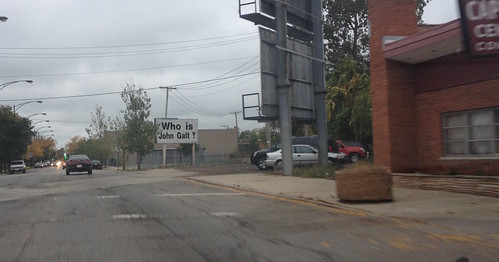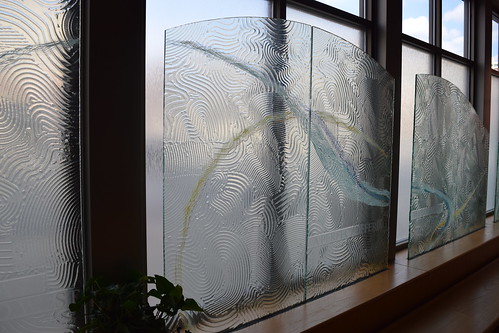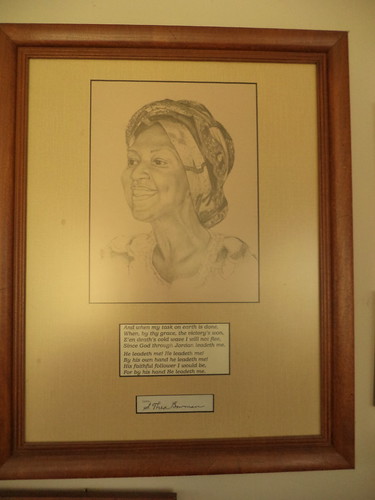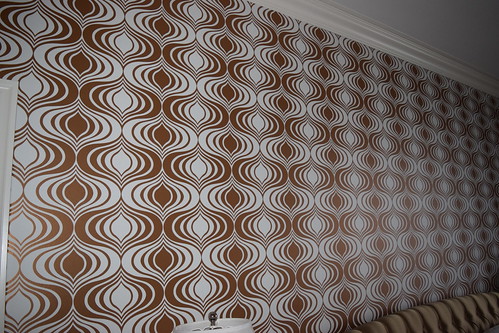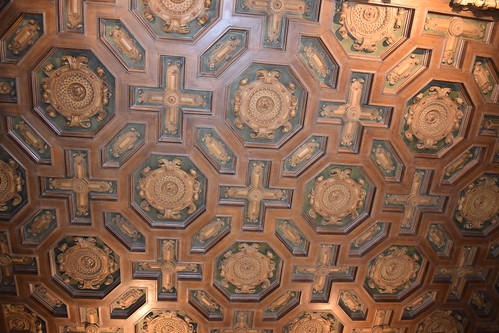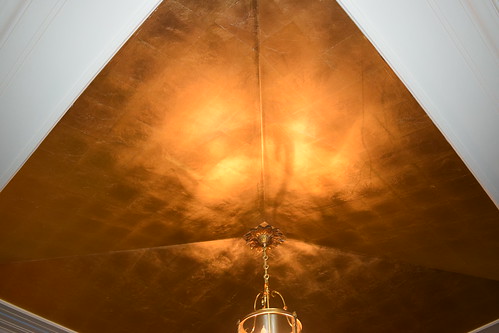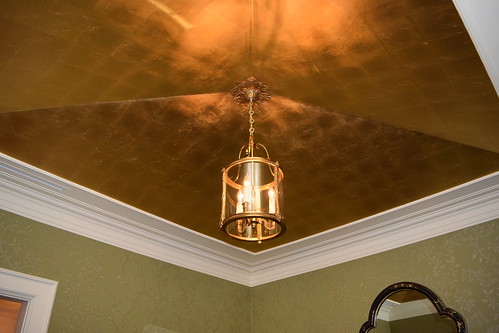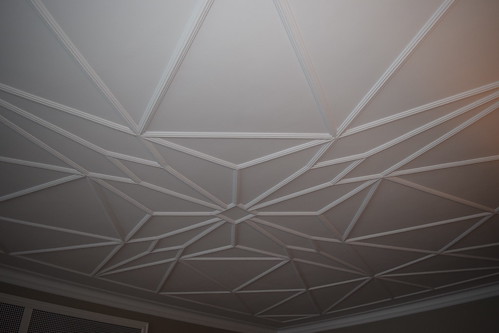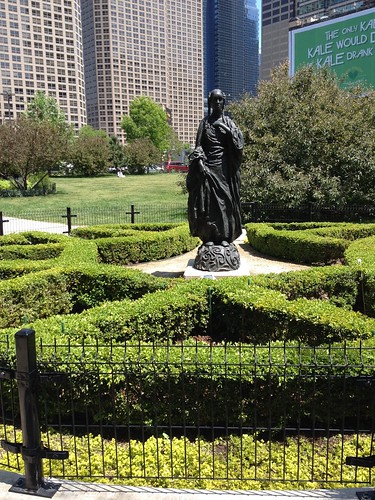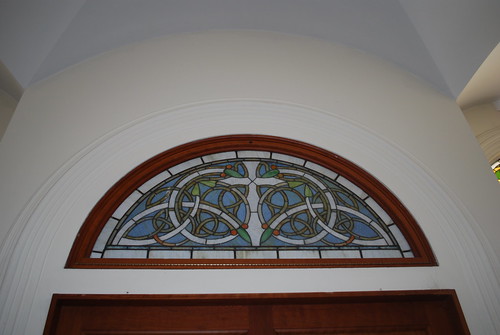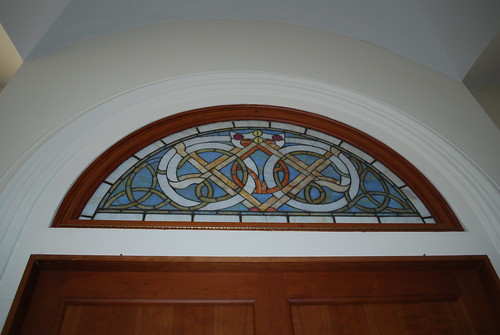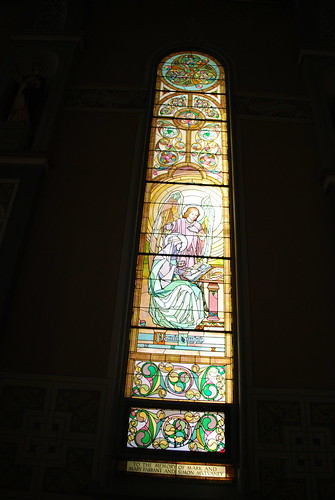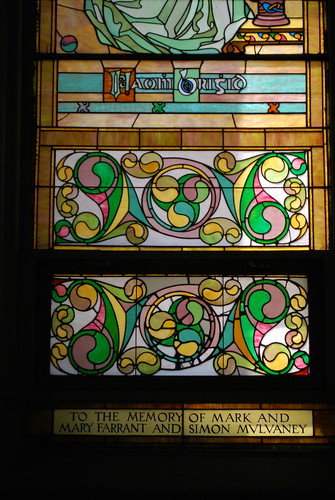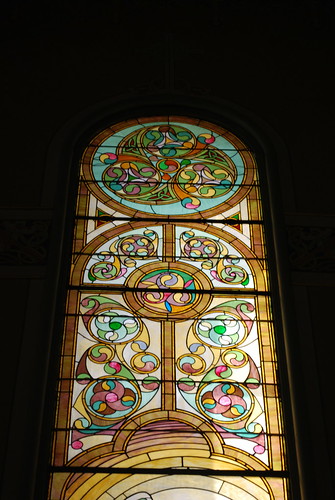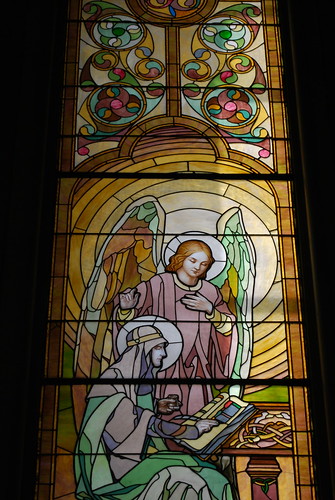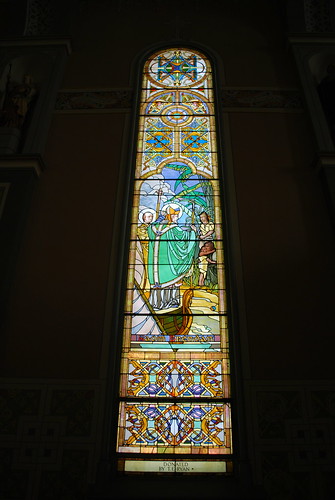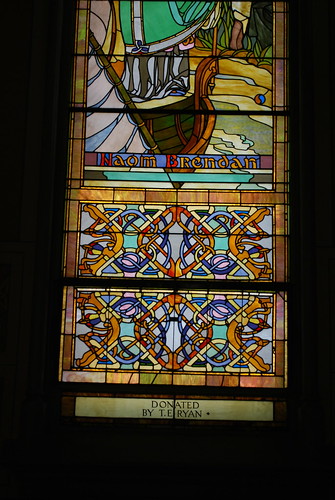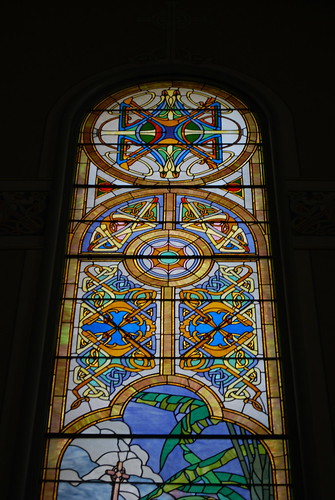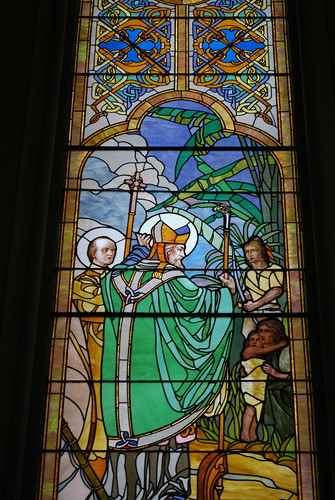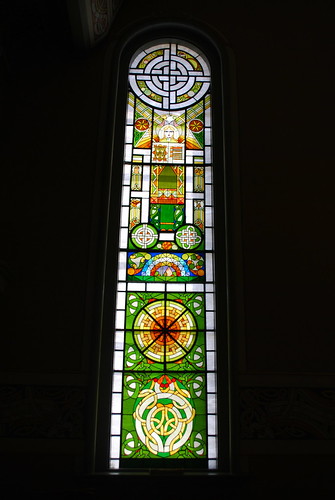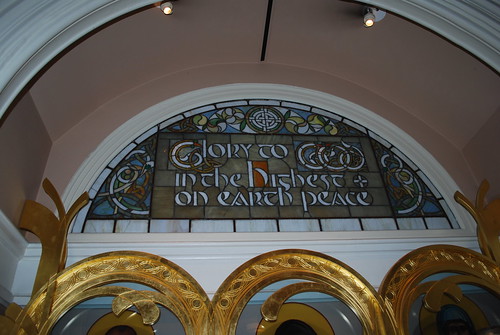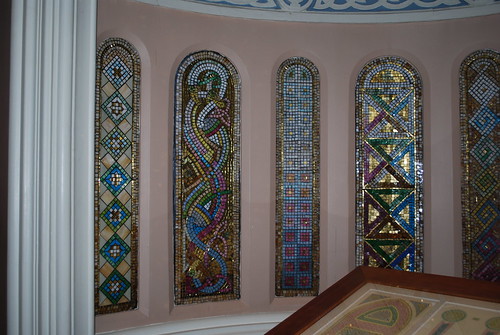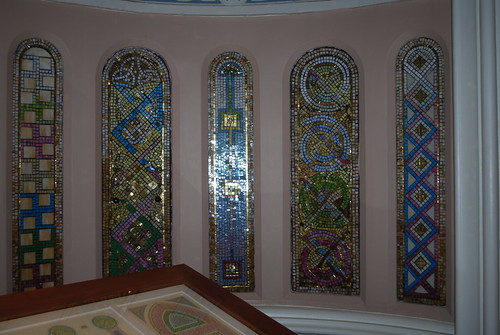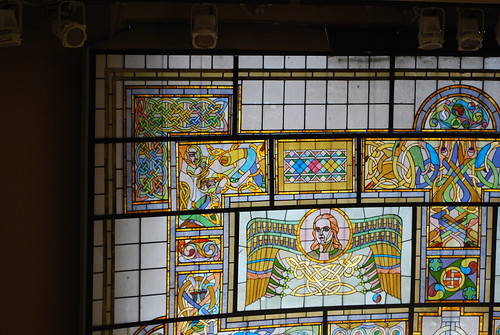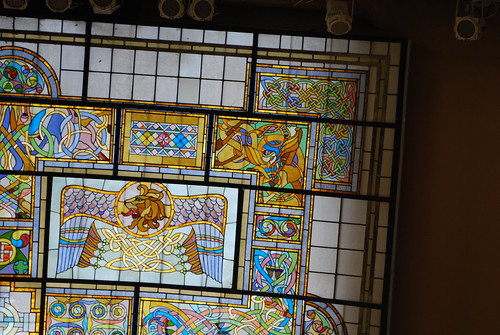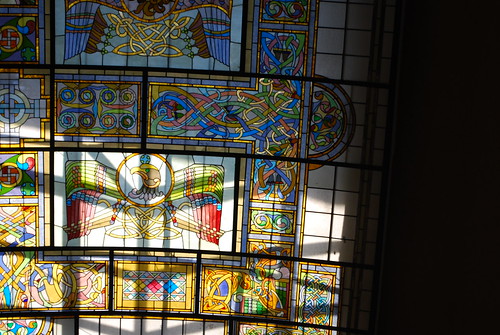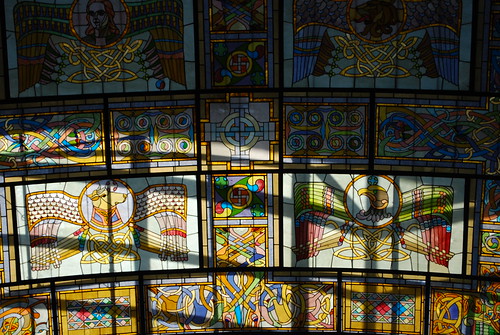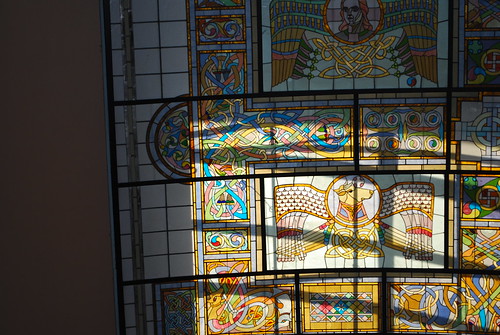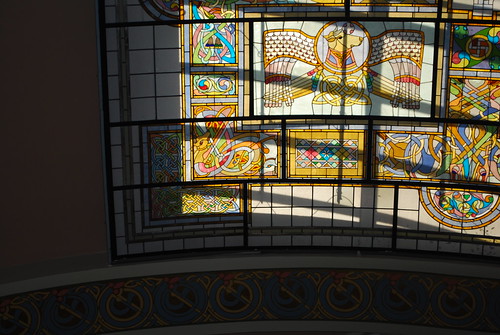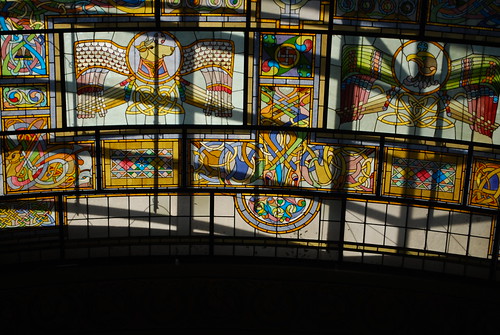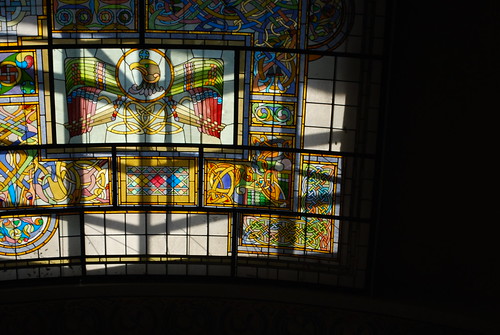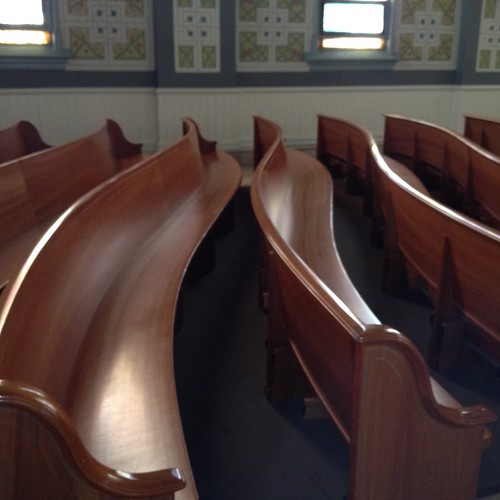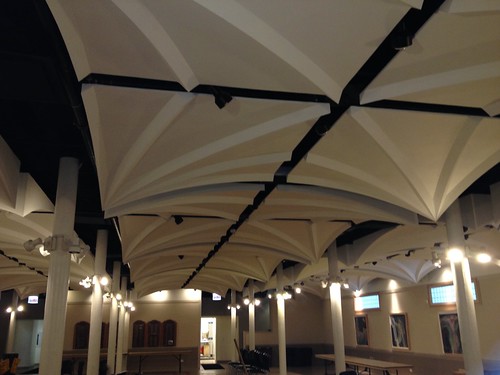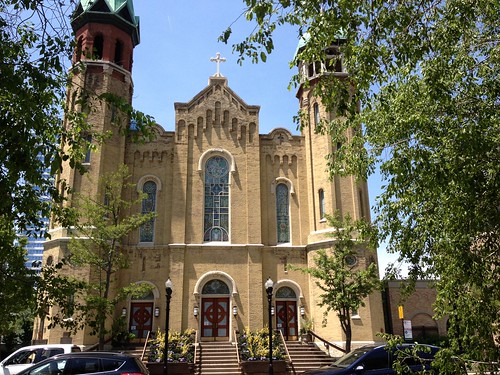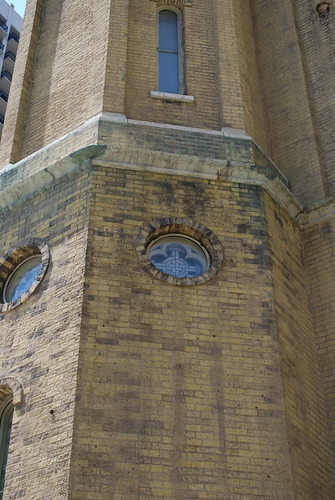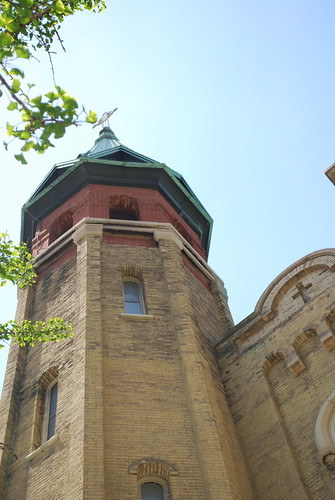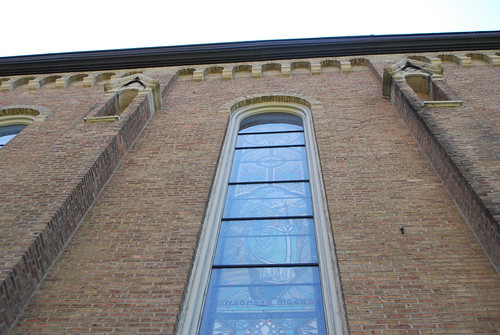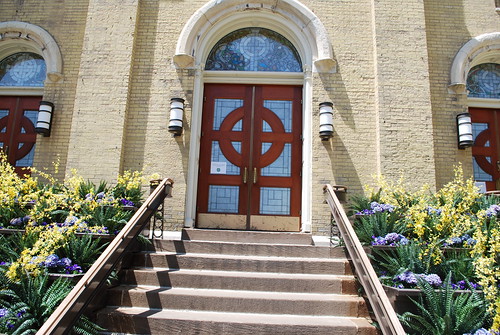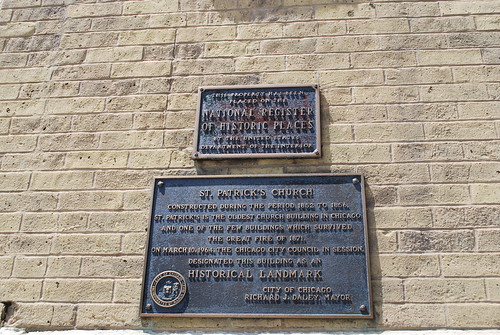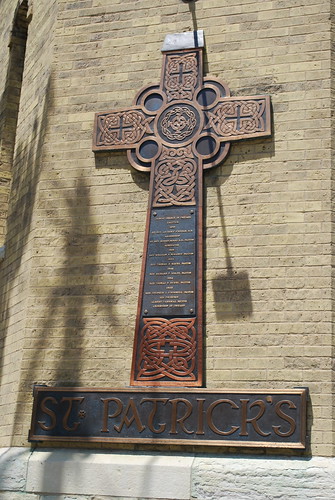Last fall, I had the joy of inspecting a fairly new library in the Albany Park neighborhood of Chicago. What could be more exciting? An English major in a library BEFORE it opens. I had to wander the stacks too because I had to look at the ceiling where the stacks were. I have an observation which was eye-opening to me.
Libraries in multi-cultural neighborhoods need to have books in the languages of their neighbors.
I feel like such a dork for not realizing that. Of course, I don't know which Asian language or languages this is, but there was a whole row of such books. It also made me realize that, although I knew it, lending libraries are global. If you speak Spanish, but your library doesn't carry Spanish-language books, the reach of a lending library means you can get books in your language. This is a head-to-desk realization.
When I was growing up, inter-library loan was a thing. Mainly, it was in the loaning of large print or Braille books. I knew people who would go to the local library and ask for the list of large print books. They had to wait awhile because these came from the big libraries or, in some cases, the university libraries, but they would arrive to our little library in Monona. I remember the librarian let me see one. Whoa! 18, 24, 28 point type. A 150 page book could balloon in page size to double that. You could kill small animals with the size of the book. But the librarian emphasized that people with failing eyesight should be allowed to read, too.
Libraries have had to remake themselves as the world goes digital. The days are long gone where you could wander the stacks of a library, finding treasures in the back; books which hadn't been checked out in 10 years. I loved to look through those, even if I didn't check them out. My local library has removed some of their stacks, replaced by an increase in the display area of periodicals (I'm not against that.), more music and movie offerings; and more classes. I have a cross-stitch club I go to every fourth Tuesday of the month, assuming I'm not traveling. There are more computers available for those without reliable access. But the large number of stacks, which I remember wandering in the 1980's, are gone. It's just the nature of a library nowadays. If I want something, they can get it via inter-library loan, but I do miss wandering and finding something I didn't know existed.
This library in Albany Park, was sparse from a browsing point of view. They are heavily focused into community programs. Being part of the Chicago Library system, there is no need to have a vast amount of paper materials in the building. Instant access in requesting books is provided. You can do it yourself from one of the terminals around the library. They have an outdoor reading area where you bring your own things or books you have checked out. It was quite inviting.
I have great fondness for the library I grew up with. That is probably as much due to the librarian who was very invested in getting kids and their parents to read. It was just assumed you went there. That libraries address the reading needs of their diverse communities should not have come as a surprise to me. I'm kind of ashamed it never occurred to me before I had to inspect one.
Beverage: Water
Deb
Showing posts with label Chicago. Show all posts
Showing posts with label Chicago. Show all posts
Wednesday, June 14, 2017
The Things I See; A Library's Goodies
Labels:
books,
Chicago,
cross-stitch,
inspections,
language,
library,
memories,
Monona,
work
Thursday, April 13, 2017
Things I See, part two.
There is a sign on the northwest side of Chicago, near Albany Park.
I seem to remember a billboard campaign utilizing this opening line from Ayn Rand's novel, Atlas Shrugged. I have never read that particular book. Rand doesn't interest me. But this tattered billboard has me trying to remember the ad campaign.
It may also have been a reaction by someone with a political motive. Atlas Shrugged has been co-opted by a number of people and used as an example of anti-government writings. Protests against banking institutions; the Tea Party; and Congressman Ron Paul; have all used this phrase, or referenced it.
In my travels, I've seen a lot of vacant billboards along the highway. The churn rate for advertising along Interstates must be rather large. This area of Chicago, while slightly busy in the morning and at night, is not the place urging the protest of government would be effective. It's incredibly easy to miss seeing this. The other billboard you see just off center, also says, "Who is John Galt?" but because that billboard faces the sun, it's very weathered. I wonder who is paying for these or if that detail has been lost to the winds.
Who is John Galt indeed?
Beverage: Orange Juice
Deb
I seem to remember a billboard campaign utilizing this opening line from Ayn Rand's novel, Atlas Shrugged. I have never read that particular book. Rand doesn't interest me. But this tattered billboard has me trying to remember the ad campaign.
It may also have been a reaction by someone with a political motive. Atlas Shrugged has been co-opted by a number of people and used as an example of anti-government writings. Protests against banking institutions; the Tea Party; and Congressman Ron Paul; have all used this phrase, or referenced it.
In my travels, I've seen a lot of vacant billboards along the highway. The churn rate for advertising along Interstates must be rather large. This area of Chicago, while slightly busy in the morning and at night, is not the place urging the protest of government would be effective. It's incredibly easy to miss seeing this. The other billboard you see just off center, also says, "Who is John Galt?" but because that billboard faces the sun, it's very weathered. I wonder who is paying for these or if that detail has been lost to the winds.
Who is John Galt indeed?
Beverage: Orange Juice
Deb
Labels:
advertising,
Chicago,
literature,
question,
travel,
work
Wednesday, March 22, 2017
Name Dropped
I had to inspect a Seminary on the south side of Chicago. The building was over 100 years old; typical Chicago brick construction. It had always been apartments with warehousing on the lower floors. Old Chicago apartments have a distinctive design. Maybe it's true of all apartment buildings from that era; tiny rooms with small hallways. The seminary has retained quite a bit of the flavor of the building while modernizing it for priests. There is a communal dining area and a chapel with custom glass designs.
The chapel area was, before the seminary bought the building, an artist's studio. But the large space with the 2.5 story ceiling, was too much to keep up so he sold to the building owner and moved north. The priest who took me around to do the inspection said they rent the space to Russian Orthodox and non-denominational congregations for worship. They are pleased it's being used.
During the course of the inspection, the seminarian walking around with me was excited to talk about the next phase of his studies. He was going to Chile in June, for 3 months, but the 2nd week of March, he was going to Greenville, Mississippi, to help the order down there. They have, he said, a strong presence in that area of the country and all the seminarians spend time working there. I looked at him. "Greenville? I know Greenville." He registered surprise as I don't have a Southern accent, couldn't even fake one if I tried. "How do you know Greenville?" Well, the head of the English department where I went to college was a Franciscan sister originally from Greenville. "Wow. Small world," he said.
The priest with us now turns to me and asks, "Who was this sister? That's kind of specific because we're the only order down there. There isn't a convent." "Her name was Sister Thea Bowman. She started at a Sacred Heart school and joined the convent there. When she went to Viterbo for college, she joined the Franciscans, who, as you know, founded Viterbo." The priest stared at me. "You studied under Thea?" I did. She recruited me for the English department and got, then, Viterbo College, to offer me enough scholarship money that 75% of my college experience was paid for. He looked at me.
"I know Thea. Everyone in Sacred Heart knows Thea. Thea is held up as a paragon for activism. You knew her. I am singularly impressed." I have a pencil sketch of her hanging in my living room. She was the most amazing person I think I have ever met. I will never, in my entire life, be half the person she was.
"Madame, I knew you were a very interesting person when we shook hands. I am convinced of it now. I never had the pleasure of meeting Thea. To know she taught you gives me more respect for you."
I didn't know quite how to react to this. I don't know people I could drop into a sentence. One of the guys from the construction company building the hotel for which I needed to do this inspection, was dropping names left and right. "Well, when I got married, I couldn't have some of the Chicago Bears come to my wedding because my wife said they would upstage her." You know some of the Chicago Bears? "Oh yeah, I'm good friends with...", and then he rattles off 5 names from the 1985 Super Bowl team. He knows this person and that person from Chicago politics or Chicago celebrity.
I am always suspect of such people. Do they really know them as in, could they call these people up and ask them to come meet for lunch? Or, is it a way of getting something because we believe in the power of "Six Degrees of Separation" and we want to be associated, however minimally, with someone "famous". There's no reason you couldn't drop any celebrities name into a sentence as being an acquaintance even if the best you know them is from the Access Hollywood TV show. I have no way to prove you don't know them.
Thea sang at my wedding. I have a cassette tape of it and I sometimes think it would be wonderful to extract that part to have. I wouldn't know where to go to get that digitized. I would never have thought to bring up her name in any of the Catholic places I have been. It was a toss-away remark, made by a young man, excited to further his faith which allowed me to say, with much pride, "I knew Thea. I was taught by Thea." I carry her lessons. When I read Shakespeare's comedies with their sexual innuendo, I can hear her voice say, "Well, we're going to jump over those lines because you're Viterbo students and you won't get the joke." Of course that made us read and reread the lines looking for what was funny.
I also feel the priest was impressed with my skills to begin with. Tara and I kind of have that effect. We have been openly dismissed by men who think we can't possibly know what we're doing and then we do it and, um, yeah, about that dismissal. Father John didn't dismiss me. He said what I did was one of the most interesting jobs he'd seen. But the knowledge of having known Thea added a layer of competency. She gave a lot to her students. She still gives. Wish I could call her and tell her.
Beverage: Scottish Breakfast Tea
Deb
The chapel area was, before the seminary bought the building, an artist's studio. But the large space with the 2.5 story ceiling, was too much to keep up so he sold to the building owner and moved north. The priest who took me around to do the inspection said they rent the space to Russian Orthodox and non-denominational congregations for worship. They are pleased it's being used.
During the course of the inspection, the seminarian walking around with me was excited to talk about the next phase of his studies. He was going to Chile in June, for 3 months, but the 2nd week of March, he was going to Greenville, Mississippi, to help the order down there. They have, he said, a strong presence in that area of the country and all the seminarians spend time working there. I looked at him. "Greenville? I know Greenville." He registered surprise as I don't have a Southern accent, couldn't even fake one if I tried. "How do you know Greenville?" Well, the head of the English department where I went to college was a Franciscan sister originally from Greenville. "Wow. Small world," he said.
The priest with us now turns to me and asks, "Who was this sister? That's kind of specific because we're the only order down there. There isn't a convent." "Her name was Sister Thea Bowman. She started at a Sacred Heart school and joined the convent there. When she went to Viterbo for college, she joined the Franciscans, who, as you know, founded Viterbo." The priest stared at me. "You studied under Thea?" I did. She recruited me for the English department and got, then, Viterbo College, to offer me enough scholarship money that 75% of my college experience was paid for. He looked at me.
"I know Thea. Everyone in Sacred Heart knows Thea. Thea is held up as a paragon for activism. You knew her. I am singularly impressed." I have a pencil sketch of her hanging in my living room. She was the most amazing person I think I have ever met. I will never, in my entire life, be half the person she was.
"Madame, I knew you were a very interesting person when we shook hands. I am convinced of it now. I never had the pleasure of meeting Thea. To know she taught you gives me more respect for you."
I didn't know quite how to react to this. I don't know people I could drop into a sentence. One of the guys from the construction company building the hotel for which I needed to do this inspection, was dropping names left and right. "Well, when I got married, I couldn't have some of the Chicago Bears come to my wedding because my wife said they would upstage her." You know some of the Chicago Bears? "Oh yeah, I'm good friends with...", and then he rattles off 5 names from the 1985 Super Bowl team. He knows this person and that person from Chicago politics or Chicago celebrity.
I am always suspect of such people. Do they really know them as in, could they call these people up and ask them to come meet for lunch? Or, is it a way of getting something because we believe in the power of "Six Degrees of Separation" and we want to be associated, however minimally, with someone "famous". There's no reason you couldn't drop any celebrities name into a sentence as being an acquaintance even if the best you know them is from the Access Hollywood TV show. I have no way to prove you don't know them.
Thea sang at my wedding. I have a cassette tape of it and I sometimes think it would be wonderful to extract that part to have. I wouldn't know where to go to get that digitized. I would never have thought to bring up her name in any of the Catholic places I have been. It was a toss-away remark, made by a young man, excited to further his faith which allowed me to say, with much pride, "I knew Thea. I was taught by Thea." I carry her lessons. When I read Shakespeare's comedies with their sexual innuendo, I can hear her voice say, "Well, we're going to jump over those lines because you're Viterbo students and you won't get the joke." Of course that made us read and reread the lines looking for what was funny.
I also feel the priest was impressed with my skills to begin with. Tara and I kind of have that effect. We have been openly dismissed by men who think we can't possibly know what we're doing and then we do it and, um, yeah, about that dismissal. Father John didn't dismiss me. He said what I did was one of the most interesting jobs he'd seen. But the knowledge of having known Thea added a layer of competency. She gave a lot to her students. She still gives. Wish I could call her and tell her.
Beverage: Scottish Breakfast Tea
Deb
Labels:
Catholic Church,
Chicago,
inspections,
memories,
Shakespeare,
Sister Thea,
Viterbo College,
work
Friday, February 10, 2017
Things I See - Exploding Eyeballs Edition
I was in a space some time ago where this was the wallpaper in one of the rooms.
I've been trying to think of something complimentary to say but I simply cannot. This was on all four walls. If this had been a bedroom, I could not imagine sleeping here. I have no idea of the age of this wallpaper.
I just put this out there for you to look at. I see a lot of design which inspires me, but I also see a lot which befuddles me, completely and totally.
Beverage: Assam tea
Deb
I've been trying to think of something complimentary to say but I simply cannot. This was on all four walls. If this had been a bedroom, I could not imagine sleeping here. I have no idea of the age of this wallpaper.
I just put this out there for you to look at. I see a lot of design which inspires me, but I also see a lot which befuddles me, completely and totally.
Beverage: Assam tea
Deb
Look Up
How many of us look up? Seriously. When you're going from point A to point B, do you look up, straight ahead or down? I have to admit I tend to look down. I've reached the age where not falling is a thing to be savored so I watch where I walk. And, I find a lot of loose change, but there is so much above our heads which we don't see because we look straight ahead or we are looking down. Here is a case in point.
Is that not a different ceiling? It was in the entry of a building where I had a couple of inspections. The building is over 100 years old. I have no idea if the ceiling is original and lovingly restored, or something from a later renovation. It's just different.
Here is the ceiling of the area outside the elevator on the floor where I had inspections.
Finally, this was the ceiling of a room I inspected.
Granted, I would notice things like this because I get paid to look at the floors, walls and ceilings, but it made me realize that looking up gives you more beauty than your narrow down or across focus. I wonder what other ceilings I've missed.
Beverage: Hot Cocoa
Deb
Is that not a different ceiling? It was in the entry of a building where I had a couple of inspections. The building is over 100 years old. I have no idea if the ceiling is original and lovingly restored, or something from a later renovation. It's just different.
Here is the ceiling of the area outside the elevator on the floor where I had inspections.
I was told this is gold leaf. This is not original to the building but was added in the 1920's. You can see the edges of the thin sheets of gold.
Finally, this was the ceiling of a room I inspected.
Granted, I would notice things like this because I get paid to look at the floors, walls and ceilings, but it made me realize that looking up gives you more beauty than your narrow down or across focus. I wonder what other ceilings I've missed.
Beverage: Hot Cocoa
Deb
Thursday, February 9, 2017
The Things I See - Public Space - Part 4
One final note on Old St. Patrick's Church. One weekend every summer, the intersection of Adams and Halsted is closed for "The World's Largest Block Party". I remember when they held their first one. It was to raise money to fix something in the church. Membership had declined and the Archdiocese of Chicago was considering closing the church. The block party was touted as a way for the city to recognize the historic significance of the church and to support keeping it alive. I think the party stretched over a weekend. Now, it's just one full day, but proceeds still benefit the church and its attached school.
At the time of the first block party, the neighborhood was crumbling. I'm thinking it was early 1980's when they did the first one. In my 17 years with Vibra-Tech, I've seen huge redevelopment of the area around the church. There are groceries and restaurants and condos. Channel 26, WCIU, is here. Oprah's old studio is a half-mile away. That site is currently being redeveloped. A lot of the seedy bars have been removed. A hotel is going in up the street. Greektown starts immediately south of the church and there are many restaurants which have come into that area.
Across the street is a park. The park contains a statue.
On this day, the benches in the park were full of people eating lunch, reading, listening to music, looking at their phones, etc.
The statue, a gift from Chicago's sister city, Galway, Ireland, is meant to represent the Irish immigrants who left their homeland and came, specifically, to Chicago. These immigrants built and maintained this church.
The green space to the north and east of this statue had children playing. Every city needs these kinds of spaces. There is a parking lot to the north which I can see becoming redevelopment material at some point, given all the construction in the area. But this space won't be developed. That's good.
Beverage: Assam Tea
Deb
At the time of the first block party, the neighborhood was crumbling. I'm thinking it was early 1980's when they did the first one. In my 17 years with Vibra-Tech, I've seen huge redevelopment of the area around the church. There are groceries and restaurants and condos. Channel 26, WCIU, is here. Oprah's old studio is a half-mile away. That site is currently being redeveloped. A lot of the seedy bars have been removed. A hotel is going in up the street. Greektown starts immediately south of the church and there are many restaurants which have come into that area.
Across the street is a park. The park contains a statue.
On this day, the benches in the park were full of people eating lunch, reading, listening to music, looking at their phones, etc.
The statue, a gift from Chicago's sister city, Galway, Ireland, is meant to represent the Irish immigrants who left their homeland and came, specifically, to Chicago. These immigrants built and maintained this church.
The green space to the north and east of this statue had children playing. Every city needs these kinds of spaces. There is a parking lot to the north which I can see becoming redevelopment material at some point, given all the construction in the area. But this space won't be developed. That's good.
Beverage: Assam Tea
Deb
Things I See - Colored Glass - Part 3
Our final examination of Old St. Patrick's Church centers on the glass. Light entering a church has always been associated with the presence of the divine. You can, however, be agnostic or even atheistic and still appreciate the art of stained glass windows.
It abounds in Old St. Pat's. Transoms above doors bear not so simple Celtic knots.
These are glass, not painted.
They have the defects seen in any stained glass window which has been around for a very long time; cracked pieces and cracking in the leading between the pieces. You can see the tri-cornered design in both of the windows. This is said to represent the trinity; Father, Son and Holy Spirit or Ghost.
When I do buildings containing stained glass, part of my inspection is to record the state of the windows. This means taking full-length views. This is the Annunciation of Mary.
Notice the scrolled design at the bottom of the window.
This is repeated above the main panel.
I like the juxtaposition of the almost watercolor figures with bolder colors on the top and bottom. I could see the circular design at the top of the window done as a rug or a needlework.
Here is the middle of the window; the angel
and Mary.
The faces are painted to give them depth. It's very hard to do stained glass to represent, correctly, the face. Subtle gradations in shade are just hard to do.
I present another window to show the dynamic colors.
I don't remember what this commemorated. It's obviously a priest coming ashore to spread the gospel.
There might have been some identifying plaque near the window, but I don't remember. What I liked about this one was the colorful knots below and above the figures.
Here are the central figures.
Again, their faces were painted onto the glass. The blue and yellow pieces with the color gradients were pieces of glass in their own right. I did not see paint on them.
This is a window in the choir loft.
The emerald green we associate with Ireland is on display here.
There were two side alcoves at the back of the sanctuary. This one contained relics of the saints.
Above it was a stained glass transom.
The south alcove was a mosaic-lined area with a half-dome stained glass ceiling.
There was a sign in front of the alcove giving you a description of each panel and what it meant.
The flash from the camera caused the colored tiles to glow.
Mosaics are amazing creations. I didn't have time to spend to read up on the significance of these panels. I've always wanted to do mosaics. I admire the ability to break a design down to colored pieces of glass and to place those pieces so a larger design emerges.
I do not know if the dome is back lit in any way. It was a bright sunny day when I did the inspection so the colors and intricacies of the dome were clear.
The highlight of the crafter's art was above the altar. In the post below, I showed photos of the general ceiling; the richly detailed painting and the arched choir level with it's multiple paint. The altar area had a massive stained glass panel. It's too big to document in one photo.
These three photos are the middle row.
And finally, the "back" row.
Isn't that just amazing? The ceiling is reinforced and the window is protected on the outside. I do not know if it's illuminated at night. That would be an amazing sight. Imagine sitting in these pews looking up into color.
Imagine being surrounded by color. In times of anxiety, I can see this spot being a place of rest. I sat in the pews for a moment and they are quite comfortable.
This is a "working" church, meaning it has an active congregation. They had redone the basement to provide better lavatories and an acoustic ceiling in their fellowship hall for music.
They serve a multi-ethnic congregation, although it is most Hispanic now. I had to take all this in and do my job before the noon worship service.
The church encourages people to come and be in the space.While I was there, at least a dozen tourists came, walked about and left. I felt a bit conspicuous when Catholics would come in, take a seat, kneel, and start to pray. Here I am, talking into a tape recorder. "Overviews of window number 3 on the wall 3. Crack in the lower left corner of the frame."
And, no matter how often I do it and no matter how much permission I have, I still feel awkward walking behind or up onto the altar area. It's a place of reverence and respect. Although I feel less religious than in previous years, a feel this space needs to be respected, but I have to do my job. Who is this lady with the tape recorder and the camera taking photos of the side of the altar? It's much better when the church is usually closed and I have to inspect it. Then I don't feel that I'm intruding on another's need for worship.
If you are in the Chicago area and are looking for an off-the-beaten path place of history, come here. The church is open at 9 with a noon worship. I managed to finish my work at 11:50. I saw a lot of people going into the church for that worship. The bells tolled at 11:45 and again at noon. There is a school to the north of the church, but you can't miss this since it's at the corner of Adams and Halsted. You can't count on weather in Chicago but if you get a brilliantly sunny day, you won't be disappointed in the windows.
This is one of the reasons I love my job. I get to be in places like this.
Beverage: Assam tea
Deb
It abounds in Old St. Pat's. Transoms above doors bear not so simple Celtic knots.
These are glass, not painted.
They have the defects seen in any stained glass window which has been around for a very long time; cracked pieces and cracking in the leading between the pieces. You can see the tri-cornered design in both of the windows. This is said to represent the trinity; Father, Son and Holy Spirit or Ghost.
When I do buildings containing stained glass, part of my inspection is to record the state of the windows. This means taking full-length views. This is the Annunciation of Mary.
Notice the scrolled design at the bottom of the window.
This is repeated above the main panel.
I like the juxtaposition of the almost watercolor figures with bolder colors on the top and bottom. I could see the circular design at the top of the window done as a rug or a needlework.
Here is the middle of the window; the angel
and Mary.
The faces are painted to give them depth. It's very hard to do stained glass to represent, correctly, the face. Subtle gradations in shade are just hard to do.
I present another window to show the dynamic colors.
I don't remember what this commemorated. It's obviously a priest coming ashore to spread the gospel.
There might have been some identifying plaque near the window, but I don't remember. What I liked about this one was the colorful knots below and above the figures.
Here are the central figures.
Again, their faces were painted onto the glass. The blue and yellow pieces with the color gradients were pieces of glass in their own right. I did not see paint on them.
This is a window in the choir loft.
The emerald green we associate with Ireland is on display here.
There were two side alcoves at the back of the sanctuary. This one contained relics of the saints.
Above it was a stained glass transom.
The south alcove was a mosaic-lined area with a half-dome stained glass ceiling.
There was a sign in front of the alcove giving you a description of each panel and what it meant.
The flash from the camera caused the colored tiles to glow.
Mosaics are amazing creations. I didn't have time to spend to read up on the significance of these panels. I've always wanted to do mosaics. I admire the ability to break a design down to colored pieces of glass and to place those pieces so a larger design emerges.
I do not know if the dome is back lit in any way. It was a bright sunny day when I did the inspection so the colors and intricacies of the dome were clear.
The highlight of the crafter's art was above the altar. In the post below, I showed photos of the general ceiling; the richly detailed painting and the arched choir level with it's multiple paint. The altar area had a massive stained glass panel. It's too big to document in one photo.
These three photos are the middle row.
Isn't that just amazing? The ceiling is reinforced and the window is protected on the outside. I do not know if it's illuminated at night. That would be an amazing sight. Imagine sitting in these pews looking up into color.
Imagine being surrounded by color. In times of anxiety, I can see this spot being a place of rest. I sat in the pews for a moment and they are quite comfortable.
This is a "working" church, meaning it has an active congregation. They had redone the basement to provide better lavatories and an acoustic ceiling in their fellowship hall for music.
They serve a multi-ethnic congregation, although it is most Hispanic now. I had to take all this in and do my job before the noon worship service.
The church encourages people to come and be in the space.While I was there, at least a dozen tourists came, walked about and left. I felt a bit conspicuous when Catholics would come in, take a seat, kneel, and start to pray. Here I am, talking into a tape recorder. "Overviews of window number 3 on the wall 3. Crack in the lower left corner of the frame."
And, no matter how often I do it and no matter how much permission I have, I still feel awkward walking behind or up onto the altar area. It's a place of reverence and respect. Although I feel less religious than in previous years, a feel this space needs to be respected, but I have to do my job. Who is this lady with the tape recorder and the camera taking photos of the side of the altar? It's much better when the church is usually closed and I have to inspect it. Then I don't feel that I'm intruding on another's need for worship.
If you are in the Chicago area and are looking for an off-the-beaten path place of history, come here. The church is open at 9 with a noon worship. I managed to finish my work at 11:50. I saw a lot of people going into the church for that worship. The bells tolled at 11:45 and again at noon. There is a school to the north of the church, but you can't miss this since it's at the corner of Adams and Halsted. You can't count on weather in Chicago but if you get a brilliantly sunny day, you won't be disappointed in the windows.
This is one of the reasons I love my job. I get to be in places like this.
Beverage: Assam tea
Deb
Labels:
Catholic Church,
Celtic,
Chicago,
church,
color,
history,
inspections,
Irish,
religion,
stained glass windows,
work
Friday, February 3, 2017
Things I See - Architecture of Religion, Part 1
I meant to post this last year shortly after I inspected this building but things got crazy and it never happened. But, something like this doesn't have an expiration date for blogging so here goes.
Chicago is an old city. Someone has lived in this location for, probably, a thousand years, be it Native Americans or settlers. Father Jacques Marquette and explorer Louis Joliet stopped in Chicago as they made their way up and down the Great Lakes and the Mississippi River watershed.
I'm rather delinquent in exploring the rich history of Chicago and Chicagland. I know 'of' things but that's often the extent of it. Being an introvert, the mere act of getting out of the house is a victory and although I love history, love being in historical places, going to those places can be an effort for me. So, when the inspection job takes me some place historical, it is a huge bonus. I get to be in the space; savor and soak up the history as I do my job. I also get to "stay as long as necessary" to get a job done and that can include engaging people at the location in a discussion of the stories of the place. The Stephen Douglas memorial was one place from 2014.
A place on the radar of "history I know about but have yet to see" is Old St. Pat's Church in what is considered the "west loop" area of Chicago. It sits adjacent to the Greektown neighborhood, with the aroma of restaurants wafting through the streets when the breeze is from the south.
Old St. Pat's is the oldest continually active church in Chicago. A church has been on this site since 1846, founded by Irish Catholic immigrants. The current building, which you see here, dates from 1856. It survived the Great Chicago Fire. The job to which we were attached is kitty corner from this building so it was necessary to inspect the church. I drooled.
The architecture is based on the Romanesque style which dates to Medieval Europe.
It's a symmetrical design, which you can see here in the towers which have 8 sides, with the lower part having circular windows in each wall. It's kind of a nightmare to inspect a tower like this because there aren't really "floors" as you climb.
You can see how the stairs go because of the windows.
And you see how deeply recessed the windows are, another detail of Romanesque architecture. It gives a modicum of protection from the elements to the window frames, but makes it difficult for me to check the exterior condition of those frames. I must check there is caulking around each window and that said caulking is in good condition, not cracked or deteriorated. Telephoto lenses do a good job. I don't determine if cracked caulking means the window is in danger of falling out. I just report if the caulking is cracked or missing, or if the window frame, itself, is good or has broken or rotten places, for instance. I also report on the state of the panes in a window. Are they good or, as is sometimes the case, broken. I see a lot of broken glass block windows, particularly at street or sidewalk level in basements or garden apartments.
When I was in an art history class in college, I wrote a paper on what makes a church gothic. For Romanesque style, there are the thick walls and columns, bearing the weight of the roof and the walls themselves. There is the symmetry of the octagonal spires which, although capped differently, have the same number of windows. There were the same number of windows on the side walls and something I hadn't noticed before, which, I'm sure, is on other medieval church designs.
Notice the niches at the top of the columns at the roof. This is the north side of the building. Here's a somewhat close up of one of the niches from the south side.
You can see the evenly spaced, symmetrical, arches in between the columns. There are 8 niches on each side. This is a very interesting detail. At one point, statues of saints used to be in each niche. But, Chicago's harsh weather caused the statues to deteriorate faster than anticipated. So, they were removed and the niches left blank.
The front symmetry of the front is found with the three panels and the doors.
The doors have been replaced many times over the course of the churches history. These are the current incarnations, incorporating celtic design. The stained glass panels above the doors are original.
The flower beds on either side of the front door are a recent addition.
The flowers made the front so inviting.
On the southeast corner, the left tower in the front photo, there is a plaque.
This briefly explains the historic significance of the church. If you like architecture and/or celtic design, you do well to swing by.
Beverage: Water
Deb
Chicago is an old city. Someone has lived in this location for, probably, a thousand years, be it Native Americans or settlers. Father Jacques Marquette and explorer Louis Joliet stopped in Chicago as they made their way up and down the Great Lakes and the Mississippi River watershed.
I'm rather delinquent in exploring the rich history of Chicago and Chicagland. I know 'of' things but that's often the extent of it. Being an introvert, the mere act of getting out of the house is a victory and although I love history, love being in historical places, going to those places can be an effort for me. So, when the inspection job takes me some place historical, it is a huge bonus. I get to be in the space; savor and soak up the history as I do my job. I also get to "stay as long as necessary" to get a job done and that can include engaging people at the location in a discussion of the stories of the place. The Stephen Douglas memorial was one place from 2014.
A place on the radar of "history I know about but have yet to see" is Old St. Pat's Church in what is considered the "west loop" area of Chicago. It sits adjacent to the Greektown neighborhood, with the aroma of restaurants wafting through the streets when the breeze is from the south.
Old St. Pat's is the oldest continually active church in Chicago. A church has been on this site since 1846, founded by Irish Catholic immigrants. The current building, which you see here, dates from 1856. It survived the Great Chicago Fire. The job to which we were attached is kitty corner from this building so it was necessary to inspect the church. I drooled.
The architecture is based on the Romanesque style which dates to Medieval Europe.
It's a symmetrical design, which you can see here in the towers which have 8 sides, with the lower part having circular windows in each wall. It's kind of a nightmare to inspect a tower like this because there aren't really "floors" as you climb.
You can see how the stairs go because of the windows.
And you see how deeply recessed the windows are, another detail of Romanesque architecture. It gives a modicum of protection from the elements to the window frames, but makes it difficult for me to check the exterior condition of those frames. I must check there is caulking around each window and that said caulking is in good condition, not cracked or deteriorated. Telephoto lenses do a good job. I don't determine if cracked caulking means the window is in danger of falling out. I just report if the caulking is cracked or missing, or if the window frame, itself, is good or has broken or rotten places, for instance. I also report on the state of the panes in a window. Are they good or, as is sometimes the case, broken. I see a lot of broken glass block windows, particularly at street or sidewalk level in basements or garden apartments.
When I was in an art history class in college, I wrote a paper on what makes a church gothic. For Romanesque style, there are the thick walls and columns, bearing the weight of the roof and the walls themselves. There is the symmetry of the octagonal spires which, although capped differently, have the same number of windows. There were the same number of windows on the side walls and something I hadn't noticed before, which, I'm sure, is on other medieval church designs.
Notice the niches at the top of the columns at the roof. This is the north side of the building. Here's a somewhat close up of one of the niches from the south side.
You can see the evenly spaced, symmetrical, arches in between the columns. There are 8 niches on each side. This is a very interesting detail. At one point, statues of saints used to be in each niche. But, Chicago's harsh weather caused the statues to deteriorate faster than anticipated. So, they were removed and the niches left blank.
The front symmetry of the front is found with the three panels and the doors.
The doors have been replaced many times over the course of the churches history. These are the current incarnations, incorporating celtic design. The stained glass panels above the doors are original.
The flower beds on either side of the front door are a recent addition.
The flowers made the front so inviting.
On the southeast corner, the left tower in the front photo, there is a plaque.
This briefly explains the historic significance of the church. If you like architecture and/or celtic design, you do well to swing by.
Beverage: Water
Deb
Labels:
architecture,
Catholic Church,
Celtic,
Chicago,
history,
Irish,
religion,
work
Subscribe to:
Posts (Atom)

